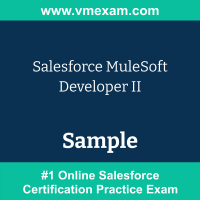 We have prepared Salesforce MuleSoft Developer II certification sample questions to make you aware of actual exam properties. This sample question set provides you with information about the Salesforce MuleSoft Developer II exam pattern, question formate, a difficulty level of questions and time required to answer each question. To get familiar with Salesforce Certified MuleSoft Developer II exam, we suggest you try our Sample Salesforce MuleSoft Developer II Certification Practice Exam in simulated Salesforce certification exam environment.
We have prepared Salesforce MuleSoft Developer II certification sample questions to make you aware of actual exam properties. This sample question set provides you with information about the Salesforce MuleSoft Developer II exam pattern, question formate, a difficulty level of questions and time required to answer each question. To get familiar with Salesforce Certified MuleSoft Developer II exam, we suggest you try our Sample Salesforce MuleSoft Developer II Certification Practice Exam in simulated Salesforce certification exam environment.
To test your knowledge and understanding of concepts with real-time scenario based questions, we strongly recommend you to prepare and practice with Premium Salesforce MuleSoft Developer II Certification Practice Exam. The premium certification practice exam helps you identify topics in which you are well prepared and topics in which you may need further training to achieving great score in actual Salesforce Certified MuleSoft Developer II exam.
Salesforce MuleSoft Developer II Sample Questions:
Answers:
|
Question: 01 Answer: a |
Question: 02 Answer: d |
Question: 03 Answer: b |
Question: 04 Answer: a |
Question: 05 Answer: d |
|
Question: 06 Answer: b |
Question: 07 Answer: c |
Question: 08 Answer: d |
Question: 09 Answer: c |
Question: 10 Answer: b |
Note: Please update us by writing an email on feedback@vmexam.com for any error in Salesforce Certified MuleSoft Developer II certification exam sample questions
